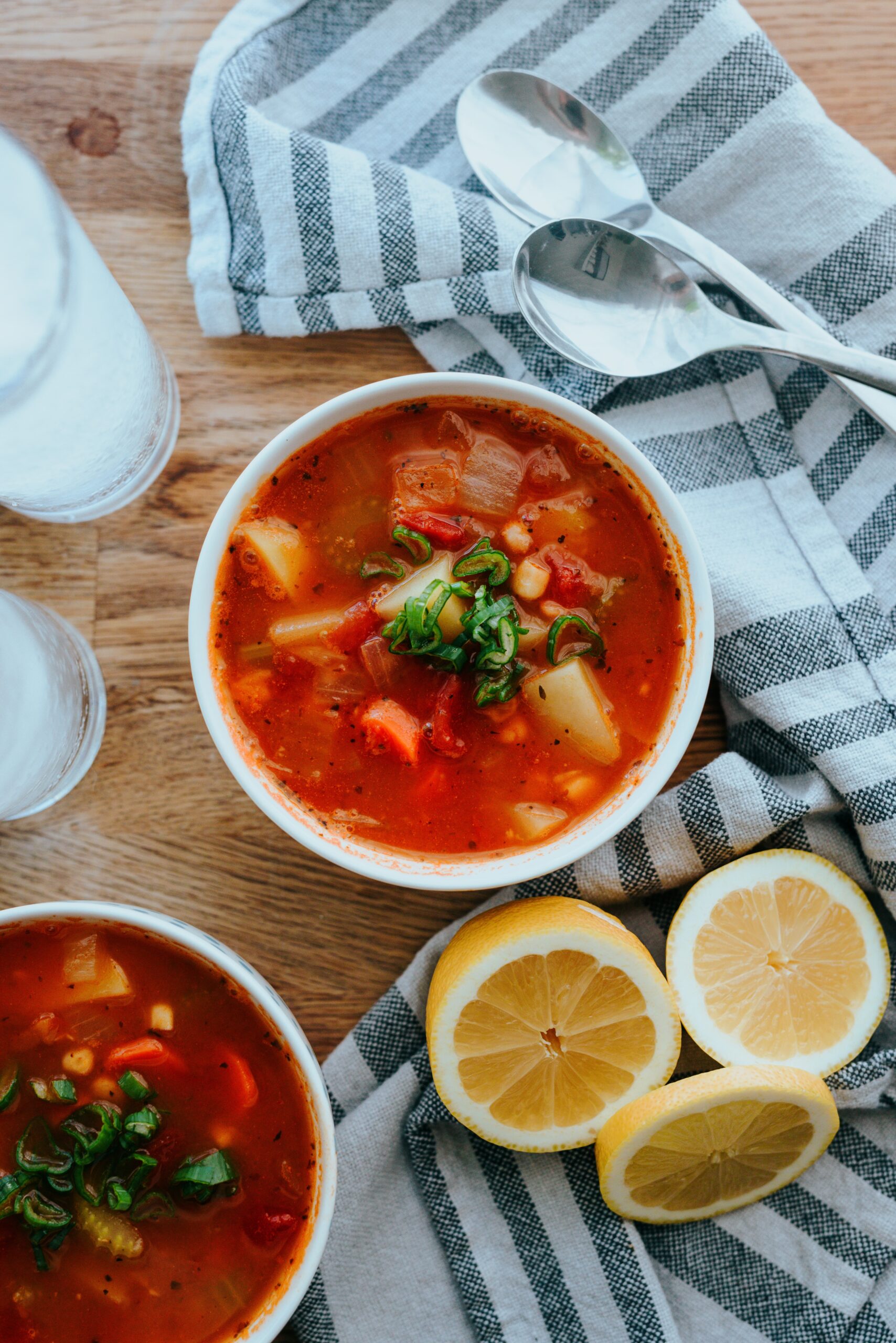Contents
- 1 Introduction
- 2 Minestrone soup
- 3 Ingredients
- 4 4 tablespoons extra-virgin olive oil
- 5 1 medium yellow onion, finely chopped
- 6 2 stalks celery, finely chopped
- 7 2 carrots, peeled and finely chopped
- 8 Salt and pepper
- 9 4 cloves garlic, minced
- 10 1 zucchini, diced
- 11 1 cup green beans, cut into ½-inch pieces
- 12 ¼ head cabbage, thinly shredded
- 13 1 bay leaf
- 14 1 sprig fresh thyme, plus leaves for garnish (optional)
- 15 1 (28 ounce) sprig fresh tomatoes, coarsely chopped
- 16 1 large bunch kale or Swiss chard, stems removed and leaves torn into large pieces (4 cups)
- 17 2 tablespoons tomato paste (optional)
- 18 8 ounces small pasta shapes such as elbows or shells
- 19 Grated Parmesan cheese for garnish (optional)
- 20 Conclusion
Introduction
I’m a big fan of soup. It’s one of my favorite things to eat, especially when it’s hot out and there are no other options but to stay inside and watch TV (in my case, Netflix). But not all soups are created equal—some are too watery, some have too much liquid or not enough vegetables or herbs. So here’s the secret: The key to making any type of soup delicious is balance! If you get your ingredients right (and use the right kind), then you’ll end up with something that tastes like nothing else on earth—like a bowlful of sunshine in your belly!
Minestrone soup

- 4 tbsp olive oil (extra virgin)
- 1 onion
- 2 stalks celery
- 2 carrots
- 4 garlic cloves
- 1 zucchini
- 1 cup green beans
- 1/4 head cabbage
- 1 bay leaf
- 1 sprig fresh thyme
- 1 can sprig fresh tomatoes
- 1 bunch kale or Swiss chard
- 2 tbsp tomato paste
- 8 ounces small pasta
- Grated Parmesan cheese for garnish (optional)
salt and pepper
Ingredients
Minestrone soup is a warm, comforting meal that can be made with a variety of vegetables. The following recipe includes beans, pasta, potatoes and more!
- 1 tablespoon olive oil
- 2 cups chopped onion (about 1 large onion)
- 2 carrots, diced (about 1 cup)
- 4 cloves garlic minced or crushed in food processor
- 2 cans cannellini beans drained and rinsed well (or substitute other white bean like Great Northern or navy)
- 3 cups vegetable broth or water plus an additional cup if you want your soup thicker than it would be with just plain water. You can also add some clam juice if you have some lying around from last night’s clam chowder!
4 tablespoons extra-virgin olive oil
Olive oil is a healthy fat. It’s high in monounsaturated fats, which have been shown to reduce the risk of heart disease and certain cancers. Olive oil also has a number of other health benefits: it contains vitamin E, antioxidants (including flavonoids), omega-3 fatty acids and carotenoids (which may help prevent age-related macular degeneration).
Olive oil is an excellent source of monounsaturated fatty acids (MUFAs), which can help reduce cholesterol levels as well as reduce inflammation throughout your body. MUFAs are found in many varieties of nuts like almonds, walnuts and pistachios—but they’re also present in olives!
1 medium yellow onion, finely chopped
You can use a red onion, but I prefer the sweetness of yellow onions.
Make sure that the onion is finely chopped. If you have a food processor, this will be easy to do. If not, use a knife and chop your onions as finely as possible with kitchen shears or cleaver (or whatever else comes to mind).
2 stalks celery, finely chopped
To chop celery, use a knife to cut the celery into small pieces.
- How do I prepare celery?
- What do I do with chopped celery?
2 carrots, peeled and finely chopped
2 carrots, peeled and finely chopped
1 large sweet potato (about 1 lb), peeled and cut into 1-inch pieces
1 tablespoon olive oil or vegetable broth
2 cups water or chicken broth
2 teaspoons dried rosemary, crushed with your fingers (or substitute another herb for a different flavor)
Salt and pepper
Salt and pepper are the most basic seasonings, but they can be used to enhance flavor, add heat, or just make things taste better.
Salt is used to enhance flavors by drawing out water from foods and making them more flavorful. It also adds a salty element that many people enjoy when eating vegetables or meats (and even some other dishes). Pepper adds heat by stimulating nerve receptors in your mouth that send signals to your brain about how hot something is; this creates feelings of warmth or spice on your tongue. You can add salt at any stage of cooking—it’s easiest if you do it while cooking—but adding pepper late in the game will create an intense kick without ruining the soup!
4 cloves garlic, minced
If you’re using fresh garlic, mince it with a knife. If you prefer to use a garlic press, that’s fine, too!
You can also add more or less depending on personal taste and what kind of soup you’re making.
1 zucchini, diced
Zucchini is a summer squash that’s rich in vitamins A and C, potassium, and fiber. It can be grilled or baked for a healthy side dish.
- 1 zucchini, diced
- 1 onion (optional)
1 cup green beans, cut into ½-inch pieces
- Cut the beans into ½-inch pieces with a knife or vegetable peeler.
- If you’re using a knife, cut each bean lengthwise into two halves, then cut each half into three pieces.
¼ head cabbage, thinly shredded
Cabbage is one of the most versatile foods in your pantry. It can be used to add flavor without adding a lot of calories, or it can make a delicious side dish. In this recipe, cabbage is mixed with salt and let sit for 15 minutes before being rinsed and drained.
The cabbage will keep well in an airtight container for up to 5 days if stored in the refrigerator; however, if you want to use it right away—or even save some for later—store cabbage loosely wrapped in a paper towel or sealed plastic bag at room temperature (60°F).
1 bay leaf
Bay leaves are an aromatic herb that is used in soups, stews and sauces. They can be found both whole and ground, but they should always be added with care as they will burn if you add too much at once. Bay leaves are a common ingredient in Italian cuisine because of their flavor, so if you’ve got one sitting around your kitchen or pantry (or even if you don’t), use it up!
1 sprig fresh thyme, plus leaves for garnish (optional)
1 sprig fresh thyme, plus leaves for garnish (optional)
Many people think of thyme as a fragrant herb that they use to flavor meats and vegetables. They are incorrect: thyme is actually a perennial herb with white flowers, which grows in clusters at the top of the stem. Thyme is often used in Mediterranean cuisine because it has a strong flavor that goes well with garlic and other spices—and also helps to add more flavor to soups!
1 (28 ounce) sprig fresh tomatoes, coarsely chopped
- Chop the tomatoes with a knife until they are coarsely chopped, but not in pieces.
- Add the tomatoes to a big pot and fill up with water so that it’s about 2 inches above the top of your pot (you want enough room for them to cook). Bring to a simmer over medium heat and cook until tender, 40 minutes or so!
- While this is going on, chop up some onions and carrots into small pieces so they can cook in the same pot as well!
1 large bunch kale or Swiss chard, stems removed and leaves torn into large pieces (4 cups)
1 large bunch kale or Swiss chard, stems removed and leaves torn into large pieces (4 cups)
1 teaspoon salt, divided
¼ cup olive oil
2 tablespoons tomato paste (optional)
- If you want to add a little tomato paste to the soup, feel free to do so.
- To make this recipe more kid-friendly and less spicy, substitute chicken broth for water and add 1 cup of water instead of tomato paste.
8 ounces small pasta shapes such as elbows or shells
- 8 ounces of small pasta shapes such as elbows or shells
- How much pasta to use: 1 cup, plus more if you want to serve extras
- How long to cook the pasta for: 3 minutes in boiling water (or 2 minutes under a boil)
- What to do with the cooked pasta once it’s done cooking: Drain and then toss with olive oil and salt.
Grated Parmesan cheese for garnish (optional)
For a garnish, you can sprinkle grated Parmesan cheese on top of your soup. To grate Parmesan cheese, use a microplane zester or grater. If you don’t have one of these tools, use a potato masher instead. Just take care not to tear up your fingers when handling the sharp blades!
Once you have the cheese grated into small pieces that are about 1/4 inch in size (about 6), add them to your soup just before serving—this will prevent it from getting soggy as soon as it hits heat from whatever heat source you’re using (such as an oven).
Conclusion
And that’s it! We hope you enjoyed this recipe and feel confident in making your own soup at home. Remember that food tastes better when you make it yourself, so we hope you’ll try something new with this easy recipe.
